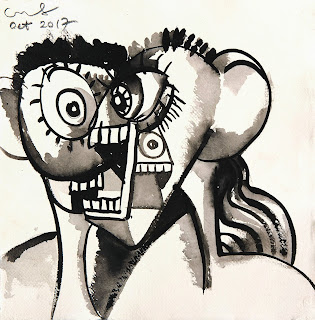George Condo
I have been away and while in Athens saw a George Condo exhibition at the Museum of Cycladic Art. It was interesting to see contemporary art alongside a wonderful collection of Ancient Greek figurines and pottery, and Condo's work I thought stood up surprisingly well in such august company. Below are a few photographs of his drawings, of which there were quite a few on display, as well as sculpture and of course paintings.
The exhibition was housed in a particularly hard to exhibit in environment, (see paintings reflected in a mirror) but the strange personages that Condo constructs were somehow able to inhabit the spaces very appropriately.
I have posted before on the continuing relevance of old masters. However in a post-modern world cartoonists are as important as classical painters. George Condo's drawings are typical of an artist that moves freely between influences as he searches for his own kind of truth. Therefore I thought it worth a more detailed look at how his work sits alongside images that I feel bear direct relationship/comparison to him. If you look at the drawings above it is easy to see a relationship between Condo and Picasso.
Picasso
Condo sort of riffs with elements of Picasso's way of working but adds into the mix other ways of image making that have influenced him. Don Martin was an artist I was fascinated by when I used to read MAD magazine as a teenager and I suspect Condo was too.
Don Martin
Look at the ears of Condo's 'cubist' heads and compare them to Martin's. Martin's head shapes are always elongated and his mouths are usually open too.
George Condo
Don Martin
George Condo
I can also sense the influence of other artists such as Wilfredo Lam and Gorky. If you look at the drawing above I think it shows a certain familiarity with some of Lam's early images and Gorky's drawings.
Wilfredo Lam
Gorky
It is also interesting to compare one of Lam's portrait heads with Condo's. A similar orchestration of elements is going on and the way Lam uses line to break up the image bears a direct comparison.
Wilfredo Lam
Not that this is anything new, you can go right back through the history of art and see how artists have improvised on and with the work of other artists. Even Picasso will at times go back and look at how other artists' work can be reinterpreted.
Velazquez and Picasso
Brown
Brown
Brown
Rembrandt
Rembrandt
Rembrandt
Freud
Freud
Glenn Brown: After Freud
Brown
Some of the images above were photographed by myself and they were behind glass, this brings in an added issue. No matter how hard I try there will be some reflection. Frances Bacon insisted that his work was shown behind glass. In the 'All Too Human' exhibition recently at Tate Britain, I was forced to keep moving in front of Bacon's images to avoid only seeing myself reflected in them. The same of course was happening when I was trying to look at Brown's work. Is this therefore an example of the continuing ongoing process of a work's becoming? Once the artist has finished making something, it continues on into the world and changes and becomes something else with each showing. Just as the artists making these images are responding to seeing other artists' work, the works themselves are responding to changing exhibition spaces and the changes in attitude that each new generation of visitors brings to looking at the work. Brown was responding to Lucien Freud's work, I was responding to my experience of looking at Brown's responses to Freud. I thought the reflections added another layer to Brown's layers of etching overlays and made the idea more about the impossibility of ever 'seeing' what an earlier artist was getting at. As you look at the images on this blog, you will be responding to them in your own way and will bring to the responses different experiences and associations. And so it goes, one thing rubs off against another, things are in constant flux and whether these images are parodies or transcriptions, impersonations or appropriations, in the long run they will all become part of a past that is constantly receding from a future, a future that will become more and more distant and therefore will read its past with further diverging narratives, narratives that will be needed by future peoples to understand themselves but which will often draw inspiration from what happened earlier.
One narrative will draw upon another, one story will influence another and the stories of art are very potent in a world that values art as a type of narrative trope for certain aspirations for the human condition. Condo and Brown riff off narratives that have already been retold many times and will be so again. In your own work you will already be deciding on a narrative that seems to be giving your practice meaning, as a story this can be something you shape and the more you are aware of it as a story, the more you will be able to shape it.



























Fabulous Content.
ReplyDeleteShop Drawings Preparation in USA